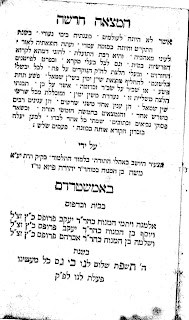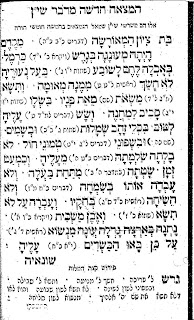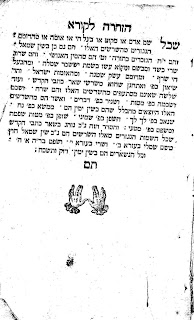Forgetfulness & Other Human Errors a New Monography by Marc Shapr
In the early part of the 20th century there was a debate of the appropriateness of women taking part in elections – whether they can vote or run for office. (Of late, this debate has been renewed by the Young Israel stance regarding women becoming a synagogue president.) Most are aware that those who argue that women cannot hold positions of power rely upon the Rambam, hilkhot melakhim 1:5, who in turn in relying upon a Sifre 147 to Devarim 17:15. R. Hirschensohn, however, understood the Sifre in a radically different manner and in doing so allowed that the Rambam erred in his interpretation of the Sifre. Specifically, R. Hirschensohn argues that the Sifre that states “that the verse (Devarim 17:15) ‘You shall place upon yourselves a king’ limits the placement to a king and not a queen” should be understood that the requirement for a king does not require a queen. That is, should the queen die she need not be replaced; however, should the king die there is a commandment to replace him.” Furthermore, according to R. Hirschensohn, the Sifre has nothing to do with the other statement from Hazal (Yevamot 45b) based on this verse, that “any leadership you shall establish should only be from your brethren [they must be Jewish].”[2] Thus, the Rambam erroneously conflated the two statements and thereby misunderstood the Sifre and came to the incorrect conclusion – that women are barred from all positions of power. As R. Hirschensohn explains “that even one as great as the Rambam in his knowledge and wisdom is not immune from error, an which then caused many who followed after him to rely upon and led to other errors. It is without a doubt the Rambam relied upon memory regarding these statements, and did not have time to reexamine them again” (See Malki ba-Kodesh 2:194).
As one would expect, aside from taking issue with R. Hirschensohn’s position on women holding power, many took issue with R. Hirschensohn’s claim the Rambam erred. R. BenZion Uziel said that although he respects R. Hirschensohn — in fact R. Uziel ultimate held like R. Hirschensohn on this issue — R. Uziel “believed that [R. Hirschensohn] erred in hastily writing such things about our master, Maimonides. For, while we may indeed take issue with his position, we may not characterize him as having committed [elementary] errors in understanding the text, or as having been mislead by custom and historical context. [R. Hirschensohn’s] remarks to such effect are, no doubt, a slip of the pen.” Mishpetei Uziel, vol. 2, Hoshen Mishpat, no. 6 (the translation comes from this article). R. Uziel was not alone in disputing R. Hirschensohn’s assessment of the Rambam as is evidenced by the many letters to R. Hirschensohn and his responses on the issue of the Rambam erring. See, e.g. Malki ba-Kodesh 4:131, 6:103-104 (letter from R. Yosef Babad).[3] It is worth noting that R. Hirschensohn seemed to have tired defending this opinion saying in one letter “that any further argument about this point is only repetitive.” Malki ba-Kodesh 6:100.
Another more recent example was noted by R. Eliezer Brodt in the magazine Datza, no. 15 (19 Kislev 5368): 4, where he calls to attention the recent edition of R. Yosef Karo’s Maggid Mesharim edited with notes by R. Yosef Kohen. In the Maggid Mesharim, amongst the many halakhic statements from the Maggid — the legendary angel that visited R. Karo and whose remarks are recorded in this work — is that “on Rosh ha-Shana one should not eat meat or drink beer [wine] and one should be careful about other foods as well. And, although Ezra said [regarding Rosh ha-Shana] ‘go eat sweet food’ that was only said for the populace, I [the Maggid] am speaking to the special ones.” The problem with this specific statement is that, as many commentaries have noted, it contradicts various Talmudic statements – including a Mishna or two – that imply one should eat meat on Rosh ha-Shana. (For more on the topic of eating meat on Rosh ha-Shana see Eliezer’s post earlier post, available here, additionally, Eliezer’s forthcoming volume on many of the customs of Rosh ha-Shana will also discuss this custom amongst others.)
Amongst the many others who attempted to explain this statement of R. Hayyim of Volozhin explained that the entire power of the Maggid only came from R. Karo himself. Thus, if R. Karo forgot a Mishna or a source then the Maggid wouldn’t know it either. Therefore, “it is clear that at that moment the Bet Yosef [R. Karo] forgot the relevant Mishna, or there was some lack in his recollection or understanding, and due to that the light [understanding] of the relevant Mishna was also held back from the Maggid.” R. David Luria, Kadmut Sefer ha-Zohar 5:4 (Koenigsberg, 1856), p. 35a (quoting R. Hayyim). Thus, according to R. Hayyim, R. Karo could forget and make mistakes.
R. Hayyim of Volozhin’s understanding, however, is completely rejected by R. Yosef Kohen in his new edition of the Maggid Mesharim. R. Kohen commenting on R. Hayyim’s explanation says “I am extremely troubled, how is it possible to say that the great Rabbi Bet Yosef, who understood and was completely fluent in the entire Talmud and Mishna, that he forgot a simple Mishna or that he was weak in a particular Mishna.” Maggid Mesharim, R. Yosef Kohen ed. (Jerusalem, 2007), 418.
Again, we see the two camps clearly, those who allow for human error and forgetfulness and those who refuse to believe great Rabbis could fall prey to these human frailties. An examination of the relevant sources shows that those in the former camp have the greatest support. To return to the Rambam that R. Hirschensohn argued erred in his understanding of the Sifre. The Rambam himself in his famous answer to the Hakhmei Lunel, admitted that he had made a mistake. Similarly, the Rambam’s son, R. Abraham when presented with a contradiction between his father’s statement and a Talmudic passage said “it is possible that my father forgot this passage when he wrote this.”
Likewise, R. Yair Hayyim Bacharach, author of Shu”t Havvot Yair, explains in a responsum “to one Godol who cast aspersions on [R. Bacharach] for claiming errors in the writings of the great earlier ones. That is, you asked how can I have the gall to dispute the earlier ones which we are much smaller. And, that I went further and said [at times] that they had forgotten the words of the Talmud and the Poskim.” R. Bacharach answered “I turn the question back on you, is not this language, that is, ‘you have forgotten [אשתמיטתיה]’ taken from the Talmud itself and applied to the greatest Amoraim . . . using [forgetfulness] is a respectful way to allege that one didn’t remember a relevant passage. Forgetfulness is human nature and affects everyone. Of course, how forgetful one is depends on the person.”
R. Bacharach then offers historical examples to support his contention. “Who is greater than Moshe the greatest prophet who forgot two laws (Shapiro notes that Bacharach erred – Moshe made three errors! (Shapiro, 52 n.220)) due to anger . . . and who is a greater Posek than the Rambam who understood the entire oral Torah as is evidenced by his work and who also authored a commentary on the entire six volumes of the Mishna based on the Talmud . . . who also forgot . . . and Rashi, who was a repository of Torah, but who writes in his commentary to the Torah . . . ‘I don’t know . . . and whom the Ramban wrote that [Rashi] forgot a passage from Midrash Ruth.” R. Bacharach continues to list other such examples. He concludes “there is no shame in saying that the Rishonim and the Achronim . . . forgot a Talmudic passage or Tosefot . . . and this position is evident from the writers in all the generations that precede me, they never held back from saying on the great ones before them.” R. Yair Hayyim Bacharach, Shu”t Hut ha-Shuni, no. 20.
It is particularly ironic that the Hida fell prey to this very type of forgetfulness as he wrote an entire book, Helem Davar, [4] showing exactly these types of mistakes in other’s works. The title of the Hida’s work, Helem Davar is rather instructive when discussing the possibility of sages erring. Helem Davar refers to the sacrifice the members of Sanhedrin would bring should they all err, indicating that even groups of great people are not immune from making mistakes.
With the above introduction we now turn to Professor Marc Shapiro’s new book Studies in Maimonides and His Interpreters (Scranton and London: University of Scranton Press, 2008), 205 pages, where one of the three articles is devoted to showing exactly the type of errors that must be attributed to forgetfulness or faulty memory that appear in the Rambam. This volume is an expanded discussion of Prof. Shapiro’s two earlier articles “Maimonidean Halakhah and Superstition” (2000) and “Principles of Interpretation in Maimonidean Halakhah: Traditional and Academic Perspectives” (2008), both of which originally published in Yeshiva University’s Maimonidean Studies, and includes a Hebrew section of several letters from two twentieth-century Torah giants (R. Joseph Kafih and R. Yehiel Yaakov Weinbeg), as well as from the nineteenth-century-maskil Nahman Isaac Fischmann to R. Samuel David Luzzatto zt”l (ShaDaL).
The “Note on Maimonides and Muhammad” found at the end of the English section requires a bit of explanation, as it speaks to the times in which we live and the sometimes precarious state of scholarship when it comes up against larger political forces. In 1993, I published an article in Judaism entitled “Islam and the Halakhah.” In the version of the article submitted to the journal, I mentioned that Maimonides referred to Muhammad as a “madman,” and in a few lines I also explained the origin of the term. When the article appeared in print, however, I was surprised to find that this had been removed without my knowledge. Naively, I thought that this was an innocent mistake, and I inquired as to what had happened. Imagine my shock when I was told that my article had been censored because the journal did not want to publish anything that could be seen as offensive to Muslims! While some may see this as understandable in the wake of the Salman Rushdie episode, it was nevertheless a betrayal of scholarship, which cannot be guided by political correctness. I would hope that any Muslims who see the “Note on Maimonides and Muhammad” will understand that its intent is not to insult their prophet, but rather to clarify a historical issue.
The editors of the Seforim blog take great pride in the first post (of hopefully many frequent posts) at this new web address being able to discuss Professor Shapiro’s new work. This is so, as Professor Marc B. Shapiro has been (as many others) a frequent contributor to the Seforim blog. It is such contributions that make the blog so much better.
[5] This argument, essentially a slippery slope argument, is also applied to making textual emendations. See, e.g. R. Y. Landau, Noda be-Yehuda Kama, Even ha-Ezer, 32; this issue is discussed by Y.S. Spiegel, Amudim be-Tolodot Sefer ha-Ivri Haghot u-Maghim, Ramat Gan, 2007, pp. 255-56.









